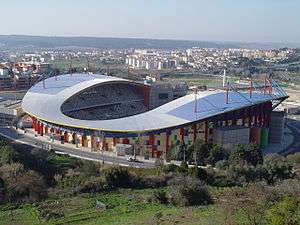Leiria
Leiria (Portuguese pronunciation: [lɐjˈɾi.ɐ] (![]()
Leiria | |
|---|---|
_(cropped).jpg) .jpg) .jpg) _(cropped).jpg) .jpg) | |
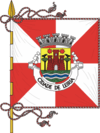 Flag 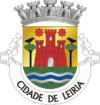 Coat of arms | |
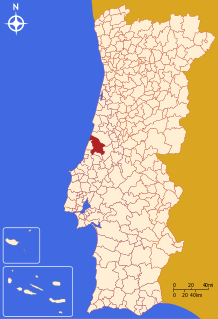 | |
| Coordinates: 39°45′N 8°48′W | |
| Country | |
| Region | Centro |
| Intermunic. comm. | Região de Leiria |
| District | Leiria |
| Parishes | 18 |
| Government | |
| • President | Raul Castro (PS) |
| Area | |
| • Total | 565.09 km2 (218.18 sq mi) |
| Population (2011) | |
| • Total | 126,879 |
| • Density | 220/km2 (580/sq mi) |
| Time zone | UTC±00:00 (WET) |
| • Summer (DST) | UTC+01:00 (WEST) |
| Local holiday | Our Lady of the Assumption May 22 |
| Website | www |
History
The region around Leiria has been inhabited for a long time, although its early history is obscure. The first evident inhabitants were the Turduli Oppidani, a Celtiberian tribe (akin to the Lusitanians), who established a settlement near (around 7 km) present-day Leiria. This settlement was later occupied by the Romans, who expanded it under the original Celtiberian name Collippo. The stones of the ancient Roman town were used in the Middle Ages to build much of Leiria.
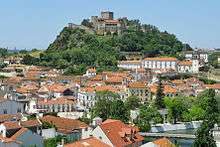
The name "Leiria" in Portuguese derives from 'leira' (from the medieval Galician-Portuguese form 'laria', from proto-Celtic *ɸlār-yo-, 'high<->ground'/'yon<->floor' akin to English 'floor(ing)', Old Irish 'làr' 'ground, floor', Breton 'leur' 'ground', Welsh 'llawr' 'floor') meaning an area with small farming plots. It was occupied for a short time by the Suebi in 414 until they were forced by the Romans to retreat to Galicia and later incorporated by Leovigild into the Visigoths kingdom in 585 A.D. Later the Moors occupied the area until it was re-captured by the first King of Portugal, Afonso Henriques in 1135, during the Reconquista. South of Leiria in that period was the so-called "no-man's land", until regions further south (like Santarém and Lisbon) were permanently taken and re-populated by the Christians. In 1142 Afonso Henriques gave Leiria its first foral (compilation of feudal rights) to stimulate the colonisation of the region.
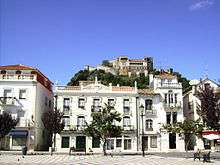
Both Afonso I of Portugal and Sancho I rebuilt the walls and the Leiria Castle to avoid new enemy incursions. Most of the population lived inside the protective city walls, but already in the 12th century part of the population lived outside the walls. The oldest church of Leiria, the Church of Saint Peter (Igreja de São Pedro), built in romanesque style in the last quarter of the 12th century, served the parish located outside the walls.
During the Middle Ages the importance of the village increased, and it was the setting of several cortes (feudal parliaments). The first of the cortes held in Leiria took place in 1245, under King Afonso II. In the early 14th century, King Dinis I restored the keep tower of the citadel of the castle, as can be seen in an inscription in the tower. He also built a royal residence in Leiria (now lost), and lived for long periods in the town, which he donated as feud to his wife, Isabel. The King also ordered the plantation of the famous Pine Forest of Leiria (Pinhal de Leiria) near the coast. Later, the wood from this forest would be used to build the ships used in the Portuguese Navigations of the 15th and 16th centuries.
In the late 14th century, King John I built a royal palace within the walls of the castle of Leiria. This palace, with elegant gothic galleries that offered wonderful views of the town and surrounding landscape, was totally in ruins but was partially rebuilt in the 20th century. John I also sponsored the rebuilding in late gothic style of the old Church of Our Lady of the Rock (Igreja de Nossa Senhora da Pedra), located inside the castle.
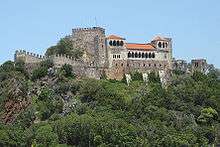
Towards the end of the 15th century the town continued to grow, occupying the area from the castle hill down to the river Lis. King Manuel I gave it a new foral in 1510, and in 1545 it was elevated to the category of city and became see of a Diocese. The Cathedral of Leiria was built in the second half of the 16th century in a mix of late manueline and mannerist styles.
Compared to the Middle Ages, the subsequent history of Leiria is of relative decay. The city was stormed by the Peninsular War, namely in 1808 (the killing of Portela, by the troops of Gen. Margaron) and the Great Fire of 1811, caused by the Napoleonic troops retreating from the Lines of Torres Vedras. In the 20th century, however, its strategic position in the Portuguese territory favoured the development of a diversified industry.
Geography and location
Leiria is located in the Centro Region and sub region of Pinhal Litoral, about halfway between Lisbon and Porto. The distance to Lisbon is 137 kilometres (85 miles), to Coimbra 70 kilometres (43 miles) and to Porto 177 kilometres (110 miles). The historic city centre spreads between the castle hill and the river Lis.
Leiria is also included in the Região de Leiria. As the main city in this community, the area of influence of Leiria spreads over the cities of Marinha Grande, Ourém, Fátima, Pombal as well the municipalities/town seats of Batalha and Porto de Mós located nearby.
Parishes
Administratively, the municipality is divided into 18 civil parishes (freguesias):[3]
- Amor
- Arrabal
- Bajouca
- Bidoeira de Cima
- Caranguejeira
- Coimbrão
- Colmeias e Memória
- Leiria, Pousos, Barreira e Cortes
- Maceira
- Marrazes e Barosa
- Milagres
- Monte Real e Carvide
- Monte Redondo e Carreira
- Parceiros e Azoia
- Regueira de Pontes
- Santa Catarina da Serra e Chainça
- Santa Eufémia e Boa Vista
- Souto da Carpalhosa e Ortigosa
Demographics
| Demographic evolution of Leiria | |||||||||||||||||||
|---|---|---|---|---|---|---|---|---|---|---|---|---|---|---|---|---|---|---|---|
| 1801 | 1849 | 1900 | 1930 | 1960 | 1981 | 1991 | 2001 | 2011 | |||||||||||
| 37,930 | 29,803 | 54,422 | 55,234 | 82,988 | 96,517 | 102,762 | 119,847 | 126,879 | |||||||||||
Climate
The city of Leiria is located near the western coast, in the central region of Portugal, with a mainly Mediterranean climate (Csb) with Atlantic oceanic influence. So it has mild and wet winters, relying on average 45 days of rain (312 mm) versus 45 dry days and 5 hours of sun per day. The average temperatures range between 15 °C (59 °F) and 7 °C (45 °F) and can lower the minimum at −3 °C (27 °F) colder days, favoring the onset of frost or ice. The springs are quite nice, being very rainy during the month of April. This season has an average of 39 days of rain 273 mm (11 in) to 51 dry days and 7 hours of sunshine per day. The average temperatures range between 20 °C (68 °F) and 11 °C (52 °F). The summers bring high temperatures and sunshine, counting on average 18 days of rain 77 mm (3 in) compared with 82 dry days and 9 hours of sunshine per day. Average temperatures range between 27 °C (81 °F) and 15 °C (59 °F), the maximum can reach 35 °C (95 °F) on the hottest days. The autumn, although mild, sometimes plagues the city with rain and wind and has on average 36 days of rain 339 mm (13 in) compared to 54 dry days and 6 hours of sun per day. Average temperatures range between 21 °C (70 °F) and 12 °C (54 °F).
Snowfalls in the city of Leiria typically occur once every 20 to 30 years. The last time it snowed in Leiria was on the 29th of 2006's January in a clammy Sunday between 10 and 12 am, during which the temperature peaked at −3 °C (27 °F).
| Climate data for Leiria | |||||||||||||
|---|---|---|---|---|---|---|---|---|---|---|---|---|---|
| Month | Jan | Feb | Mar | Apr | May | Jun | Jul | Aug | Sep | Oct | Nov | Dec | Year |
| Average high °C (°F) | 14.2 (57.6) |
15.1 (59.2) |
17.1 (62.8) |
18.9 (66.0) |
20.6 (69.1) |
23.5 (74.3) |
25.3 (77.5) |
25.9 (78.6) |
24.2 (75.6) |
21.6 (70.9) |
17.2 (63.0) |
14.6 (58.3) |
19.9 (67.8) |
| Daily mean °C (°F) | 10.8 (51.4) |
11.4 (52.5) |
13.3 (55.9) |
14.9 (58.8) |
16.6 (61.9) |
19.1 (66.4) |
20.7 (69.3) |
21.1 (70.0) |
19.9 (67.8) |
17.6 (63.7) |
13.7 (56.7) |
11.3 (52.3) |
15.9 (60.6) |
| Average low °C (°F) | 7.4 (45.3) |
7.8 (46.0) |
9.5 (49.1) |
10.9 (51.6) |
12.6 (54.7) |
14.8 (58.6) |
16.1 (61.0) |
16.3 (61.3) |
15.7 (60.3) |
13.6 (56.5) |
10.3 (50.5) |
8.1 (46.6) |
11.9 (53.4) |
| Average precipitation mm (inches) | 115 (4.5) |
108 (4.3) |
66 (2.6) |
70 (2.8) |
56 (2.2) |
30 (1.2) |
6 (0.2) |
7 (0.3) |
35 (1.4) |
82 (3.2) |
116 (4.6) |
99 (3.9) |
790 (31.1) |
| Source: Climate-data.org[5] | |||||||||||||
Culture
In addition to being a site of historical interest, the castle of Leiria provides a venue for cultural events. Nearby is the Church of Saint Peter (Igreja de São Pedro), the site of the city's annual music festival. Leiria is home to the Museu da imagem em movimento (Museum of the Moving Image)[6] as well as Portugal's restored first paper mill, Moinho do Papel (The Paper Mill),[7] the Theatre Miguel Franco in the Mercado de Sant'Ana (Saint Anne's Market)[8] and the Theatre José Lúcio da Silva[9] are venues for theatrical, musical, cinematic and dance performances.
Today the central square, Praça Francisco Rodrigues Lobo, named after the Portuguese poet Francisco Rodrigues Lobo, is home to a thriving café culture, regularly used for cultural events. The city was the principal residence of the Portuguese king, Denis, who wrote lyric poetry in the troubadour tradition, and the birthplace of the modern realist writer Eça de Queiroz, whose first novel, O Crime do Padre Amaro ("Father Amaro's Sin"), published in 1875, is set in the city.
In October 2012, Leiria opened the city's "Centro Cívico", a modern architecture building, designed to have social impact on the community. This building has the life of Eça de Queiroz as a theme. In here, there's senior classes and Associação Fazer Avançar runs SPEAK, with support from EDP and Calouste Gulbenkian Fundations, among others.
The city has several cultural entities like Leiria's Public Library Afonso Lopes Vieira, Arquivo, Ateneu, Leirena and O Nariz (theatre groups), Associação Fazer Avançar, FADE IN, Metamorfose, ECO and many others that make Leiria a culturally vibrant city, offering the busiest calendars of events.
In recent years, Leiria has seen much redevelopment on the banks of the river Liz, with the creation of several new parks, public spaces, children's play areas and a series of themed bridges. A long riverside promenade was built which is popular with walkers and joggers.
Since 2010, Associação FADE IN organizes ENTREMURALHAS, one of the most important gothic festivals in the world (List of gothic festivals).
Gastronomy
Leiria's gastronomy offers a good variety of Portuguese dishes including fresh fish dishes and the famous "Leitão" da Boavista (barbecued piglet/ suckling pig). The nearby village of Cortes is known for "Migas", a dish of corn bread with spinach, garlic and olive oil which is eaten as an accompaniment to fish or meat.
Typical Dishes: Morcela de Arroz; Negritos; Lentriscas; Bacalhoada com migas; Bacalhau com feijão frade; Ossinhos; Fritada; Cabrito; Feijoada; Leitão; Chanfana; Fritada dos peixinhos; Bacalhau com Chícharos.
Traditional sweet pastry: Brisas do Lis; Lampreia de Ovos; Ovos Folhados; Bolinhos de Pinhão; Tarte de Chícharos (Alvaiázere); Canudos de Leiria; Doce de amêndoa; Broas Doces de Batata; Merendeiras dos Santos; Filhós de abóbora.
Wines of the region : Caves Vidigal, S.A./ Vale da Mata, Cortes / Quinta da Serrinha (Vin Bio), Barreira / Santos & Santos, Torres Vedras / Quinta da Sapeira, Serra d'Aire / Paço Côrtes, Lda. IGP Lisboa, Sub-região Alta Estremadura. These wines are labeled D.O.C. (Denominação de Origem Controlada) which secures a superior quality. Also parte of the Portuguese wine region Encostas de Aire (DOC).
Panoramic view

Economy
Leiria has an economy concentrated on services and light industries. It has several industries related with plastics and moulds, as well as animal food, milling, cement, and civil construction, among other light industries. Agriculture, tourism, and state-run public services, such as education (including the Polytechnical Institute of Leiria), health (the district hospital Hospital de Santo André[10]) and general public administration, are an important part of Leiria's economy.
Monte Real Air Base, a major Military airbase of the Portuguese Air Force in Monte Real, where all Portuguese F16 fighter squadrons are stationed, is also notable employer in the region.[11]
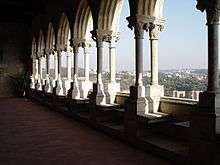
Transport
Leiria is connected to its suburbs and the rest of Portugal by a motorway network. There are four motorways passing the city;
- A1 - Auto-estrada do Norte linking Porto to Lisbon, passing by Leiria.
- A8 linking Leiria to Lisbon.
- A17 linking Marinha Grande to Aveiro.
- A19, linking Leiria and Batalha, using part of the IC2.
There is a railway Linha do Oeste (west railway line linking Cacém (Sintra/Lisbon area) to Figueira da Foz) which serves the central western coast of Portugal. Leiria railway station is a few km from the city centre (about 2 km).
The main bus station service is in the city centre. The bus service, called Mobilis, is composed by 9 lines connecting surrounding neighbourhoods and parishes of Leiria with the city centre. This includes two bus loops and a specific line (uMob) that connects the city centre with Campus 1 and 2 of the Instituto Politécnico de Leiria.
There is a small airfield (Aérodromo de Leiria), used for sports and recreation.
Leiria-based newspapers
- Região de Leiria – Weekly
- Jornal de Leiria – Weekly
- Diário de Leiria – Daily
- O Mensageiro – Monthly
Education
Leiria hosts a national public polytechnic institution of higher education, the Instituto Politécnico de Leiria[12] which has 5 campuses, 3 of them located in Leiria.
- Campus 1 - School of Education and Social Sciences (ESECS).
- Campus 2 - School of Technology and Management (ESTG) and the School Of Health Sciences (ESS)
- Campus 5 - Institute for Research, Development and Advanced Studies (INDEA), the Training Centre for the Courses of Technology Specialization (FOR.CET) with around 900 students, the Centre of New Opportunities (CNO), a Transfer Technology and Information Center (OTIC) and an E-Learning Unit (UED).
There is also a private institution, o Instituto Superior de Línguas e Administração (ISLA).[13]
In Secondary education, Leiria has the following schools, the first two in the center, the last in the outskirts.
- Escola Secundária de Francisco Rodrigues Lobo (former Liceu)[14]
- Escola Secundária de Domingos Sequeira (former Escola Comercial)[15]
- Escola Secundária de Afonso Lopes Vieira, in Gândara dos Olivais, Marrazes.[16]
In Primary education, Leiria has the following schools, teaching from the 5th grade until 9th grade.
- Escola D. Dinis[17]
- Escola Correia Mateus (with 1st cycle)[18]
- Escola José Saraiva[19]
- Escola de Marrazes[20]
- Colégio Dinis de Melo[21]
- Colégio Senhor dos Milagres[22]
Besides this there are multiple schools in the Municipality for the 1st cycle, from 1st grade until 4th grade.
Sport
The city of Leiria has its own football team, the União Desportiva de Leiria, commonly called just União de Leiria. It currently plays at the third level of Portuguese football, in the Campeonato Nacional de Seniores, but recently spent 16 seasons in the Primeira Liga.
An important facility is the Estádio Dr. Magalhães Pessoa, situated close to Leiria castle. The modern stadium has a capacity for 23,000 people and was built for the UEFA Euro 2004.[23] Efforts were made to sell it, as its debt (nearly €50M) overburdens the city finances,[24][25] União de Leiria rents the stadium, but played the 2011-12 season in Estádio Municipal da Marinha Grande due to a rent dispute.[26]
The district football in Leiria is managed by the Leiria Football Association, overseeing the regional leagues.[27]
Regarding other sports, Leiria has a notable women's handball team, Juve Lis, which plays in the Women's Handball League, and also participated in EHF competitions.[28][29] Since 2013 Leiria has had a chess academy (Academia de Xadrez) offered as an activity for young people by the Corvos do Lis. Enrolled students have won titles in National Competitions: second place by teams under 12 years old in 2014 and 2015 and a National Champion, (Blitz, 2013, Under 8) and (Super Rapid play, 2015, under 10). They work with many primary schools in the region teaching chess, considering it a useful complement to developing intellectual skills.[30]
International relations
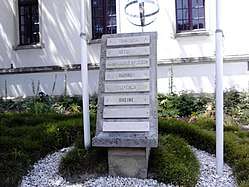
According to the National Association of Portuguese Municipalities,[31] Leiria is twinned with:






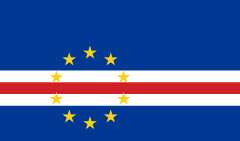



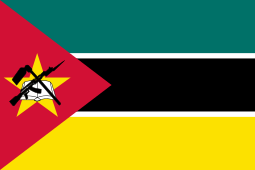


See also
References
- "Statistics Portugal". www.ine.pt. Retrieved 24 March 2018.
- "Áreas das freguesias, concelhos, distritos e país". Archived from the original on 2018-11-05. Retrieved 2018-11-05.
- Diário da República. "Law nr. 11-A/2013, page 552 61" (pdf) (in Portuguese). Retrieved 24 July 2014.
- "UMA POPULAÇÃO QUE SE URBANIZA" (in Portuguese). Retrieved 16 October 2012.
- Climate data: Leiria - Climate-data.org
- "Archived copy". Archived from the original on 2015-06-27. Retrieved 2015-06-26.CS1 maint: archived copy as title (link)
- "Moinho do Papel - C.M. Leiria". www.cm-leiria.pt. Retrieved 24 March 2018.
- "Mercado de Sant'Ana - C.M. Leiria". www.cm-leiria.pt. Retrieved 24 March 2018.
- "Teatro José Lúcio da Silva". Teatro José Lúcio da Silva. Retrieved 24 March 2018.
- "Hospital de Santo André, EPE". Hsaleiria.min-saude.pt. Retrieved 2013-12-08.
- "Base Aérea Nº 5" (in Portuguese). Retrieved 16 October 2012.
- "IP Leiria". Retrieved 16 October 2012.
- "Instituto Superior de Línguas e Administração". Archived from the original on 2012-11-08.
- "Escola Secundária de Francisco Rodrigues Lobo (ESFRL)".
- "Escola Secundária Domingos Sequeira".
- "Escola Secundária Afonso Lopes Vieira". Archived from the original on 2012-01-20.
- "Escola D. Dinis".
- "Escolas Dr. Correia Mateus".
- "Escolas do Concelho de Leiria". www.cm-leiria.pt (in Portuguese). Retrieved 2019-10-28.
- "Escola Marrazes".
- "Colégio Dinis de Melo".
- "Colégio Senhor dos Milagres".
- "Venues Guide – Leiria". BBC Sport (British Broadcasting Corporation). 25 May 2004. Retrieved 17 June 2012.
- "Câmara de Leiria admite vender estádio construído para o Euro 2004". Público. 29 December 2009. Retrieved 10 May 2015.
- "Estádio de Leiria custa 16.750 euros por dia à Câmara". Sapo.pt. 9 June 2014. Retrieved 10 May 2015.
- "Leiria constrói três relvados sintéticos na Marinha Grande". Sol. 18 July 2011. Retrieved 10 May 2015.
- "Factos Históricos da A.F. Leiria". afleiria.fpf.pt.
- "História". juvelis.pt. Archived from the original on 2015-04-16.
- "POR Juve Lis". EHF.com.
- "Clube Cultural e Desportivo Corvos do Lis". Corvosdolis.com (in Portuguese). CorvosdoLis. Archived from the original on December 18, 2015.
- "Consulta". www.anmp.pt. Retrieved 2019-10-28.
- "Câmara Municipal de Leiria". Cm-leiria.pt. Archived from the original on 2013-11-09. Retrieved 2013-03-26.
- "Geminações". www.cm-leiria.pt (in Portuguese). Retrieved 2019-10-28.
